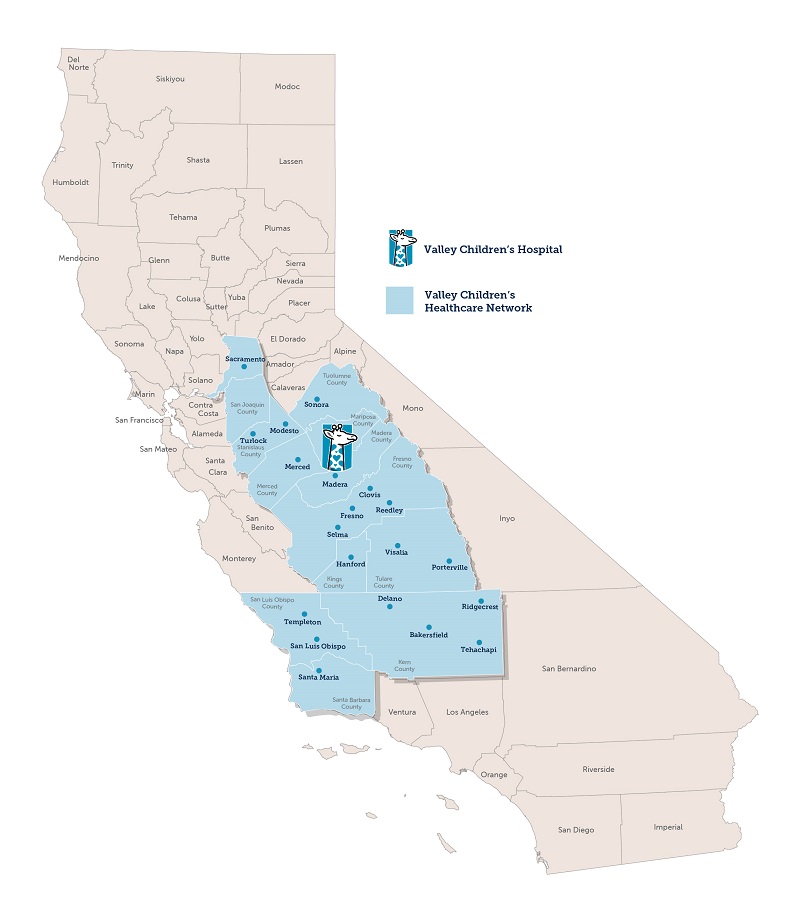As the only pediatric network of its kind in all of Central California, Valley Children’s service area extends from San Joaquin County in the north to Kern County in the south, and serves much of the Central Coast and eastern Sierra, as well. The map below illustrates Valley Children’s service area.

Children’s health outcomes are largely determined by where children live, learn and play. Across California’s Central Valley, children experience high rates of obesity, asthma, food insecurity and trauma, poor access to healthcare and unsafe sleeping environments. Across the counties we serve, children experience vastly different health outcomes. Health inequities stem from factors affecting children outside of the four walls of the hospital – often referred to as social determinants of health – that ultimately affect their health outcomes.
Valley Children’s is uniquely positioned to address many of these challenges and to help ensure a positive future for our region’s children.
Top 10 Issues Affecting Valley Kids
| Access to Care |
While we have seen improvements in access over the years, there are still communities in the Central Valley where too many children and their families have to delay or forego needed medical care due to lack of access to healthcare providers and resources.
|
| Adverse Childhood Experiences (ACES) |
Adverse childhood experiences (ACEs) are stressful or traumatic events children experience before the age of 18. Challenges children face in school, life, and ultimately with their health, are often the symptoms of ACEs and toxic stress. In our region, ACEs affect 17% of children – increasing their risk for long-term health and behavioral issues.
|
| Asthma |
Asthma is one of the most common chronic diseases in children in the U.S. and a leading cause of hospitalizations and absences from school. The Central Valley experiences some of the most dangerous air quality in the nation and asthma-related hospitalizations in our region are among the highest in the state, particularly in children.
|
| Child Abuse |
Childhood abuse or neglect has a lifelong and even an intergenerational impact on the lives of children and their families and can cause long-term physical, emotional and behavioral problems. Kern County and Stanislaus County have the highest rates of substantiated cases of child abuse and neglect in the region.
|
| Childhood Obesity |
More than one-third of fifth graders across most Central Valley counties are overweight or obese and although progress has been made in some areas, data shows that significant racial/ethnic and socioeconomic disparities persist in obesity prevalence.
|
| Food Insecurity |
Approximately one in four Central Valley children are food insecure and live in households with limited or uncertain access to adequate food. Food insecurity has direct and indirect impacts on both the physical and mental well-being of children.
|
| Maternal and Infant Health |
Central Valley counties have some of the highest rates in California of babies born prematurely, babies born at low birth weight and infants who die before the age of one.
|
| Mental Health |
Social and emotional well-being is an integral part of overall health. Approximately one in three ninth graders in the Central Valley experienced depression-related feelings.
|
| Poverty |
In many counties across the Central Valley, one third of children are living in poverty. Poverty is a social determinant of health that is inextricably linked to poor health outcomes.
|
| Unintentional Injuries |
Injury is the leading cause of death in children and young adults and injuries are a major source of childhood emergency department and hospital admissions.
|